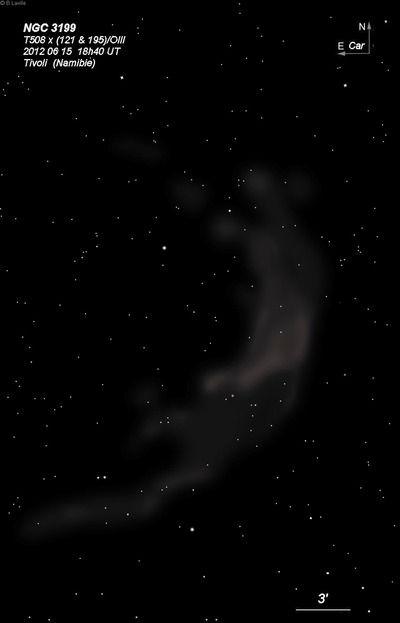
9x50mm finder (2/17/04 - Costa Rica): surprisingly, NGC 3199 was visible in the 50mm finder at just 9x by blinking with the OIII filter. An elongated bar of nebulosity was seen!
James Dunlop discovered NGC 3199 = D 332 = h3239 on 1 May 1826 and described a "very faint ray of nebula, about 2' broad, and 6' or 7' long, joining two small stars at the south following extremity, which are very slightly involved, but their lustre is not diminished from that of similar small stars in the field. The north extremity also joins a group of small stars, but they are not involved. Figure 15 [very basic sketch]." Unfortunately Dunlop made a one degree error in reading or copying the declination so he didn't receive credit in the GC or NGC (Glen Cozens recovered the identity of D 332).
John Herschel rediscovered this Wolf-Rayet nebula on 1 Apr 1834, unaware of Dunlop's earlier observation. He recorded, "A very large and very remarkable nebula, which is brighter to the S.f. part, and dies off to the N.p., having a curved form and forked tail. In the head of it is a double star. The nebula is pretty bright, very large, figure irregular, 8' long, 4' broad. Among a vast number of milky way stars." On 5 Feb 1835 (sweep 543, the night described in his diary as "most superb" and "having attained the sublime of Astronomy - a sort of ne plus ultra") he wrote, "very bright, very large, 10' long, of a concave or crescent form, sharply terminated inwards, fading away outwards. In a field of about 80 stars. The place is that of a 13th mag star, about the middle of the crescent, or rather nearer the head." His sketch from that night is reproduced on plate IV, figure 3. Later that month (sweep 552) he wrote: "pretty bright, very gradually brighter in the middle, of a falcated or semilunar shape, extending over three-quarters of the field. The place is that of a double star in its vertex or southern extremity."
Joseph Turner sketched NGC 3199 carefully on 28 Apr 1876 using the Great Melbourne Telescope (unpublished lighograph plate VII, figure 67). The SE end is tapered and brightest and the wide northwest end is forked with the eastern fork slightly brighter. A lithograph was completed but not published. Albert Le Sueur had earlier made a similar sketch with the 48", as well as Pietro Baracchi on 16 Jan 1885.
300/350mm - 13.1" (2/17/04 - Costa Rica): at 105x and UHC filter, this HII region appears as a remarkable, huge crescent, roughly 11'x7' (the main region extends nearly 1/3 of the 39' field). Opens up towards the east in a huge "C" shape. The SW portion of the crescent is brightest, although the overall surface brightness is irregular with a mottled or curdled appearance. A few stars are superimposed even with the filter with the brightest stars at the SW end. Fainter nebulosity sprouts out of the SW end, increasing the total size by several arcminutes.
400/500mm - 18" (7/8/02 - Magellan Observatory, Australia): this is an amazing HII region with a 20mm Nagler and UHC filter at 103x. It appears as a fairly bright, thick crescent opening towards the east, roughly 10'x6'! The surface brightness was quite irregular with a UHC filter and the nebulosity was noticeably brighter on the south end where a couple of brighter stars are embedded. Off the bright portion of the south end, much lower surface brightness haze extends the curve further SE for several arcmin and spreads out somewhat increasing the length to ~15'. The main mass has a curdled, mottled appearance and dark lanes appear to intrude into the nebulosity. The illuminating star HD 89358 is a Wolf-Rayet star (WR 18) and this nebulosity is reminiscent of the Crescent Nebula in Cygnus (it could be dubbed the "Southern Crescent").
600/800mm - 24" (4/11/08 - Magellan Observatory, Australia): at 200x and UHC filter this Wolf-Rayet bubble appeared as an amazing 180° crescent, open on the east side and forming a thick "C" shape. The rim of the bubble is widest on the western portion, although it is slightly brighter on the southwest side. The main portion of the crescent spans ~13' from the north to south end and appears ~3.5' thick in the middle, though fainter nebulosity spreads out to the southeast. A double star (h4302 = 10.4/11.6 at 23") is embedded near the south end. The surface brightness is fairly high overall, though irregular with slightly brighter patches, knots and streaks. A faint 5' linear streak or filament running NNW-SSE is superimposed along the outer western edge, though it separates or resolves from the Crescent at its north and south ends. The illuminating mag 10.6 Wolf-Rayet star (WR 18 = HD 89358) is located about 4' E of the center of the "C", and is asymetrically positioned with respect to the center of the entire shell. This W-R bubble is situated four degrees NW of the Eta Carina nebula in a rich Milky Way star field.
Notes by Steve Gottlieb